The ICL 2966 is the Museum's largest computer. This huge mainframe occupies almost a third of the floor space in the Large Systems Gallery!
Manufactured by the British computer giant ICL (now part of Fujitsu), TNMOC's ICL 2966 dates from 1984. The Central Processing Units occupy 5 large cabinets, with many other cabinets containing disks, magnetic tape drives and other peripherals. It was used by the construction company TARMAC until 1999, when it was decommissioned due in part to fears that it would be affected by the ‘Millennium Bug’.
Almost all large mainframes were broken up for scrap when they reached the end of their working lives, but the Museum's 2966 had a lucky escape from this fate.
At this time Tony Sale, one of the founders of the Computer Conservation Society (CCS), was working on the Colossus Rebuild at Bletchley Park. He heard about the imminent demise of the Tarmac 2966, thought to be the last surviving of its kind, through Bob Whittaker, an ICL employee and volunteer on the CCS's Manchester Baby reconstruction project. Bob and Tony thought the system should be preserved, and so it was arranged that ICL would pay to transport the system to Bletchley Park and Tony arranged space to store it.
Nearly ten years would pass before The National Museum of Computing was formed and the system could at last be taken out of storage and set up in the new Large Systems Gallery. Unfortunately the damp conditions in the semi-derelict buildings that the machine lived in for so many years have taken their toll.
The long and difficult process of restoring the system to working order has been underway since 2008 and is still ongoing. We are lucky to have had help and advice in the early days from Alasdair Lewis, the ICL/Fujitsu engineer who maintained the system during its working life at TARMAC and actually decommissioned it. He was instrumental in ensuring the all important software, cabling and spare parts were preserved and transferred to TNMOC.
This system uses a lot of power - you can't run this from a 13A plug - so the Museum had to install a dedicated mains supply before restoration could begin. It also generates a lot of heat and would normally be in an air-conditioned room. As we could not fit out the whole gallery with air conditioning, we designed a large fan-assisted air venting system fitted to the top of the main cabinets to direct the hot air out through a window.
The enormous hard disk drives used by the system are very sensitive to dust and temperature changes, and so are not suitable for regular operation in our environment. To get around this problem we designed and built a disk emulator to replace them. This small box uses a modern micro SD memory card (the type you might find in your phone) which can store twice as much data as all the original disks put together!
ICL 2900 computers were designed to run the VME (Virtual Machine Environment) Operating System, but could also run software designed for the earlier 1900 series computers. Our machine ran as a 1900 during its working life at TARMAC, and still does today at TNMOC under the George 3 operating system.
The system didn't come with any video terminals, but we have since acquired and restored three original ICL terminals. On these visitors can play noughts and crosses against the computer, or explore the twisty windy passages of the classic Colossal Cave adventure game.
The Project Team
Delwyn Holroyd has worked in the computer industry for over 25 years and has a degree in electronic engineering. His early career was in the mainframe division at ICL, before moving into the fields of non-linear editing and compositing for television and feature film. He is now technical director and co-founder of Codex Digital, an Emmy award winning company manufacturing digital recording and workflow equipment for professional cinematography.
Delwyn became a volunteer at TNMOC in 2009 and has led the 2966 team since 2010. His only prior experience of the 2966 was seeing one through the window of the machine hall at ICL West Gorton whilst working on the design teams for the successor Series 39 SX machine and the VME operating system. He attended Manchester Grammar School, which at the time operated an ICL 1902T running George 3. These experiences have proven invaluable in the restoration.
Alan Fursdon served an apprenticeship an Instrumentation technician and a further four years in the steel making plant. Then in 1974 he joined ICL as a field Service Engineer. Among the many systems he worked on were the 1904 series, 2900 range, Point of Sale and Networks. He left ICL in 1998. Moving to a small specialist company in Milton Keynes working on designing and producing small batch niche products for Communications and Network Systems.
On retirement, in 2014, Alan became a volunteer at TNMoC. Working on the 2966 and machine minding on public opening days.
John Dunn started his IT career in 1973 with Business Computers working on the BCL molecular 18. In 1976 he went to work for Vickers Management Services working on an ICL 1904S. In 1979 he started working for Telecomputing Ltd in Oxford, after a short period in the Oxford office he was sent on site to Town City Properties in London bug fixing on an integrated property management system. After over 3 years he went to work for the client and stayed with them until 2005. Working for all that time on ICL mainframes up until the autumn of 1999 when their ICL 2966 was turned off. In that time he designed and looked after a number of systems including the original property management system he fixed bugs on in 1979.
He can now be found most Sundays running the ICL 2966 having become a volunteer in 2016 after reading an article in Resurrection, the quarterly magazine of The Computer Conservation Society.





